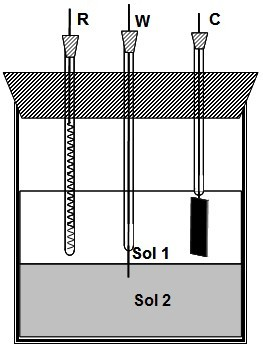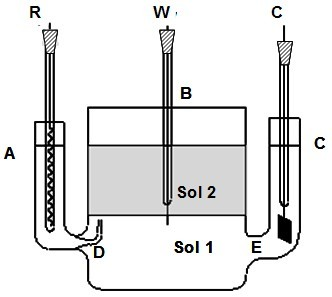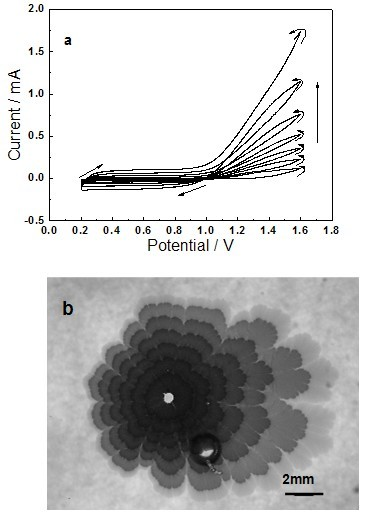Conductive poly 3,4-ethylene dioxy thiophene film and preparation method thereof
A technology of ethylene dioxythiophene and dioxythiophene membrane, which is applied in electrolytic components, electrolytic processes, electrolytic organic production, etc., can solve the problems of unfavorable product separation, unsuitable for large-scale production, human and environmental hazards, etc., and achieves polymerization. The speed is easy to control, easy to separate and purify, and the effect of improving the polymerization efficiency
- Summary
- Abstract
- Description
- Claims
- Application Information
AI Technical Summary
Problems solved by technology
Method used
Image
Examples
Embodiment 1
[0026] Embodiment 1 carries out electrochemical polymerization at the liquid-liquid interface formed by dichloromethane and water
[0027] First take a certain amount of monomer ethylenedioxythiophene (EDOT) and supporting electrolyte lithium perchlorate (LiClO 4 ) were dissolved in the organic solvent chloroform and water respectively to prepare 0.01 mol / L EDOT chloroform solution and 0.1 mol / L LiClO 4 aqueous solution; sequentially take a certain volume of EDOT chloroform solution and LiClO 4 aqueous solution in figure 1 In the single-port polymerization device shown, a clear liquid-liquid interface is formed; then a certain length of platinum wire working electrode (0.5 mm in diameter) is vertically and slowly inserted into the liquid-liquid interface, and the platinum wire is ensured to slightly exceed the liquid-liquid interface and penetrate deep into the liquid-liquid interface. The oil phase is about 0.5 mm, and the platinum auxiliary electrode and saturated calomel ...
Embodiment 1 and comparative example 1
[0031] Embodiment 1 is in 0.01 mol / L EDOT trichloromethane solution and 0.1 mol / L LiClO 4 The liquid-liquid interface formed by the aqueous solution, in comparative example 1, was polymerized by cyclic voltammetry in 0.01 mol / L EDOT aqueous solution, the potential range: 0.2 V ~ 1.6 V, and the scanning speed: 20 mV / s. The cyclic voltammetry curve in the polymerization process of embodiment 1 and the macroscopic appearance of the conductive polymer film of generation see respectively image 3 a, b, the ring voltammetry curve of comparative example 1 polymerization process sees Figure 4 (The arrows in the figure indicate the direction and trend of current change).
[0032] Compared image 3 a and Figure 4It can be clearly seen that the cyclic voltammetry curve of the process of preparing the conductive polymer in the present invention shows a very different behavior from that of the polymerization in the traditional homogeneous system, especially in the oxidation potential ...
Embodiment 2
[0034] First take a certain amount of monomer ethylenedioxythiophene (EDOT) and supporting electrolyte perchloric acid (HClO 4 ) were dissolved in organic solvent dichloroethane and water respectively, and made into 1 mol / L EDOT dichloroethane solution and 2 mol / L HClO 4 aqueous solution; sequentially take a certain volume of EDOT dichloroethane solution and HClO 4 aqueous solution in figure 1 In the single-port polymerization device shown, a clear liquid-liquid interface is formed; then a certain length of platinum wire working electrode (0.5 mm in diameter) is vertically and slowly inserted into the liquid-liquid interface, and the platinum wire is made to slightly exceed the liquid-liquid interface and penetrate into the liquid-liquid interface. The oil phase is about 0.5 mm, and the platinum auxiliary electrode and saturated calomel (SCE) reference electrode are inserted into the upper layer of HClO 4 In aqueous solution; using a constant potential of 1.4V ( vs SCE) a...
PUM
 Login to View More
Login to View More Abstract
Description
Claims
Application Information
 Login to View More
Login to View More - R&D
- Intellectual Property
- Life Sciences
- Materials
- Tech Scout
- Unparalleled Data Quality
- Higher Quality Content
- 60% Fewer Hallucinations
Browse by: Latest US Patents, China's latest patents, Technical Efficacy Thesaurus, Application Domain, Technology Topic, Popular Technical Reports.
© 2025 PatSnap. All rights reserved.Legal|Privacy policy|Modern Slavery Act Transparency Statement|Sitemap|About US| Contact US: help@patsnap.com



